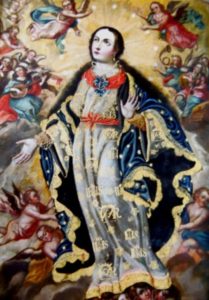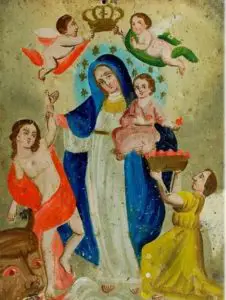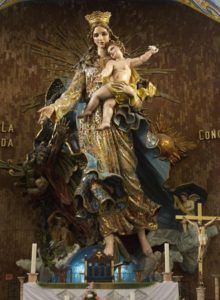Podcast: Play in new window | Download
Subscribe: Apple Podcasts | RSS
This is the second part in a series about little-known Virgin Mary images in Mexico. It would be an understatement to declare that religion is a vital part of the lives of most Mexicans. The modern country of Mexico is overwhelmingly Catholic, but some of its beliefs and rituals have foundations in its timeless indigenous past. As in other predominantly Catholic countries, the Virgin Mary, the earthly mother Jesus, plays an important role in the religious lives of Mexicans. Many different apparitions or aspects of the Virgin Mary in Mexico and many shrines devoted to her are known to many people outside the country. In fact, one of the largest religious pilgrimage sites in the entire world can be found in the heart of Mexico itself, in Mexico City, on a hill called Tepeyac. While many millions of visitors from dozens of countries make the pilgrimage to the shrine of the Virgin of Guadalupe every year, there are many smaller shrines and Marian devotions not well-known outside of Mexico or even outside their respective regions within Mexico. Here are three.
- Nuestra Señora de Tzocuilac
 A few miles southeast of the city of Puebla is the tiny town of Tzocuilac. The name of the town comes from a now-extinct Nahuatl dialect and for many years its meaning has puzzled researchers. The name Tzocuilac may come from two words, zocuitl, “mud”, and cuitlatl, meaning “dirt” or “excrement” in English. Other language scholars believe the name derives from tzocuitl, meaning “painting”, and cuilac, which translates to “that appears.” The latter interpretation of “Painting that appears” makes more sense in the context of the story of Our Lady of Tzocuilac. From a book written in 1910 about this particular virgin, the author, Father Francisco Hernández says this about the origins of this sacred image:
A few miles southeast of the city of Puebla is the tiny town of Tzocuilac. The name of the town comes from a now-extinct Nahuatl dialect and for many years its meaning has puzzled researchers. The name Tzocuilac may come from two words, zocuitl, “mud”, and cuitlatl, meaning “dirt” or “excrement” in English. Other language scholars believe the name derives from tzocuitl, meaning “painting”, and cuilac, which translates to “that appears.” The latter interpretation of “Painting that appears” makes more sense in the context of the story of Our Lady of Tzocuilac. From a book written in 1910 about this particular virgin, the author, Father Francisco Hernández says this about the origins of this sacred image:
“A well-stationed and pious cacique, named Antonio Abab Xilotl, had an image of the Blessed Virgin painted on the walls of his house. The cacique died when the plague called matlazahuatl decimated the indigenous people. As he did not leave anyone to take care of the house, it was soon ruined, the roofs collapsed and only walls were left as a den for vermin and a shelter for buzzards, which littered the walls. For many years, the image of the Blessed Virgin was exposed to rain, sun, air and frost, without the painting being damaged by the force of these elements, nor by the roots of the herbs that crumble the walls, annihilating its colors and smoothness. One day the wall of the front of the walls that kept such a beautiful relic collapsed and this circumstance led to the prodigious appearance.”
The story continues with a local priest ordering that the image be erased from the wall because he did not want it to be subject to any sort of desecration. The locals complied and scraped the image off the wall. The next Sunday, the image re-appeared on the same wall. When the priest passed by, he thought that the villagers had not obeyed his orders and asked sternly that the painting be erased again. So it was, and it appeared once more on the same crumbly wall. The priest saw the image again and became angry. Why were these people so disobedient? The frustrated father decided to scrape the wall himself. The next Sunday, he walked by and saw that the image had appeared again. Unable to explain what was going on, he declared that God was the artist who made sure the image had stayed fixed on the wall.
That old adobe wall eventually succumbed to the elements and crumbled away, but not before an artist managed to recreate the image of the Virgin on a canvas which now hangs in the local church at Tzocuilac. The current painting housed in the humble church has changed since the original image was painted sometime in the 17th Century. The portrait is of a very European-looking woman, traditionally styled as the Assumption of the Virgin Mary, with the twelve fine stars, which look like jewels, radiating from her head. She has her hands open, as if in expectation, and has thick black hair that spreads over her shoulders and her flowing cloak. The accompanying angels were painted later and date to sometime in the 18th century. The two cherubs above the Virgin’s head are raising their arms as if ready to hold something. Perhaps the artist who added these angels was also supposed to add a crown but did not finish his work. In the year 1825 gold was painted on the canvas by an artist known to history as Don Feliciano Tello, and this was the last revision to the centuries-old piece.
Because the Virgin on the original adobe wall was associated with appearing after a plague, throughout the years many people in the region have prayed to Nuestra Señora de Tzocuilac in times of epidemics. In the great plague of 1731 and again during a typhus epidemic in 1915, thousands of people prayed to the Virgin to end the mass sicknesses and then gave credit to her when people became suddenly cured. August 15th is her feast day, and many people make the journey to the small village of Tzocuilac to pray in front of this miraculous image and to give thanks.
- La Madre Santisima de la Luz
 The story of this Mexican Virgin, known in English as The Most Holy Mother of Light, begins on the Italian island of Sicily sometime in the early 1720s. An Italian Jesuit, Father Juan Antonio Genovesi, was preparing for his future missionary work in the New World and wanted to emphasize the devotion to the Virgin Mary. Father Genovesi decided he would have a painting commissioned in Italy to take with him to Mexico. The Jesuit wanted a woman to inspire the creation of the painting, and there are a few versions of the story as to who this woman was. Some say it was a nun, others say it was a very holy woman prone to having religious visions and premonitions. Others say that it was the Virgin Mary herself who would guide the painter to create the image. In either story, the artist’s hand was guided by some sort of supernatural presence or heavenly grace, and the final image is an interesting one. The painting represents Mary with a slight smile on her face looking directly at the viewer. She is carrying the Baby Jesus in her left arm. The Christ Child grabs a heart in his right hand, and with his left he takes another from a basket full of hearts presented to him by a kneeling angel. The Virgin stops with her right hand a soul about to fall into the jaws of a dragon that represents the sinner and hell. Two chubby angels keep an imperial crown on the Virgin’s head. Three seraphim are under her feet, and others on each side complete the picture.
The story of this Mexican Virgin, known in English as The Most Holy Mother of Light, begins on the Italian island of Sicily sometime in the early 1720s. An Italian Jesuit, Father Juan Antonio Genovesi, was preparing for his future missionary work in the New World and wanted to emphasize the devotion to the Virgin Mary. Father Genovesi decided he would have a painting commissioned in Italy to take with him to Mexico. The Jesuit wanted a woman to inspire the creation of the painting, and there are a few versions of the story as to who this woman was. Some say it was a nun, others say it was a very holy woman prone to having religious visions and premonitions. Others say that it was the Virgin Mary herself who would guide the painter to create the image. In either story, the artist’s hand was guided by some sort of supernatural presence or heavenly grace, and the final image is an interesting one. The painting represents Mary with a slight smile on her face looking directly at the viewer. She is carrying the Baby Jesus in her left arm. The Christ Child grabs a heart in his right hand, and with his left he takes another from a basket full of hearts presented to him by a kneeling angel. The Virgin stops with her right hand a soul about to fall into the jaws of a dragon that represents the sinner and hell. Two chubby angels keep an imperial crown on the Virgin’s head. Three seraphim are under her feet, and others on each side complete the picture.
In the year 1732 the painting of La Madre Santisima de la Luz arrived in New Spain. Church officials conducted a lottery and whichever diocese was drawn in the contest would get the painting. The city of León in the modern Mexican state of Guanajuato was the winner. On May 23, 1849, Our Most Holy Mother of Light was officially made patroness of León. She became a regional draw as many people in the surrounding area credited the Virgin with many miracles and intercessions. On October 8, 1902, the Celestial Lady was solemnly crowned by Bishop Leopoldo Ruiz y Flores, thanks to the concession made by Pope Leo XIII, on March 23, 1901. Over the years the image of this virgin has been copied and other likenesses of the Virgen de la Luz in Mexico are found in the Franciscan mission of Tancoyol, in Sierra Gorda, Querétaro; in the church of San Cayetano, in Valenciana, Guanajuato; in the Church of Nuestra Señora de la Luz in Puebla, as well as in the Metropolitan Cathedral in Mexico City.
- La Virgen de La Imaculada Concepción de Chignahuapan
In the northern mountainous part of the state of Puebla near the borders of states of Tlaxcala and Hidalgo lies the small town of Chignahuapan, home to a most unusual Virgin Mary. In the local Nahuatl dialect, the name Chignahuapan means, “Over the Nine Waters.” For thousands of years the hot springs outside of town have been known for their curative powers and many peoples throughout ancient Mexico made the trip to Chignahuapan as a health pilgrimage of sorts. The local thermal baths still draw tourists by the thousands to this area annually. In addition to the tourism generated by the hot springs, the town is known for its production of Christmas ornaments. Some 500 artists live in Chignahuapan and for generations the people here have made beautiful glass baubles that are shipped all over the world. A relatively more modern attraction in this “magical town” is the gigantic statue of the Virgin of the Immaculate Conception that draws more non-secular visitors than traditional pilgrims.
 In 1960 Father Idelfonso Illescas Pichardo, seeing that his parish was insufficient to house the number of faithful who came, took the initiative to build a larger church to house the parishioners. Twelve years later, on May 12, 1972, the church was inaugurated and, on this day also, the largest indoor religious sculpture in all Latin America was unveiled. A sculptor from the city of Puebla named José Luis Silva carved the gigantic 39-foot-tall Virgin out of cedar wood. The original design did not include the Baby Jesus, but the final product included the Christ Child with an outstretched hand holding a dove. The Virgin Mary herself looks very contemporary to the 1970s. With high cheekbones, bright blue eyes and a Charlies Angels feathered hairstyle, she seems more like a product of Hollywood than a sacred image of the Catholic Church. In 1999 her home, the Church of the Immaculate Conception, was given the designation of “Minor Basilica.” With that upgrade, the Virgin of Chignahuapan was given a pontifical crown with the blessings of Pope John Paul the Second. Also made of cedar wood, the 3-foot-tall crown is covered in gold leaf and inlaid with dozens of precious jewels. The sight of this sculpture leaves most sightseers breathless. The Minor Basilica of the Immaculate Conception receives about 5,000 visitors per month, and this may increase to about 15,000 in December. The feast day to this gigantic virgin is December 8th and on that day the church is filled with thousands of flowers which adorn the walls and are scattered on the floor. Perhaps owing to its contemporary nature, the fiestas for the Virgin of Chignahuapan are not as long-lasting as in other Mexican villages and take place only across a few days. During this holy time more pilgrims visit the image than secular tourists. As time has passed, devotees traveling to this shrine have increased and sometime soon this massive statue may be the focal point of a strong religious pilgrimage.
In 1960 Father Idelfonso Illescas Pichardo, seeing that his parish was insufficient to house the number of faithful who came, took the initiative to build a larger church to house the parishioners. Twelve years later, on May 12, 1972, the church was inaugurated and, on this day also, the largest indoor religious sculpture in all Latin America was unveiled. A sculptor from the city of Puebla named José Luis Silva carved the gigantic 39-foot-tall Virgin out of cedar wood. The original design did not include the Baby Jesus, but the final product included the Christ Child with an outstretched hand holding a dove. The Virgin Mary herself looks very contemporary to the 1970s. With high cheekbones, bright blue eyes and a Charlies Angels feathered hairstyle, she seems more like a product of Hollywood than a sacred image of the Catholic Church. In 1999 her home, the Church of the Immaculate Conception, was given the designation of “Minor Basilica.” With that upgrade, the Virgin of Chignahuapan was given a pontifical crown with the blessings of Pope John Paul the Second. Also made of cedar wood, the 3-foot-tall crown is covered in gold leaf and inlaid with dozens of precious jewels. The sight of this sculpture leaves most sightseers breathless. The Minor Basilica of the Immaculate Conception receives about 5,000 visitors per month, and this may increase to about 15,000 in December. The feast day to this gigantic virgin is December 8th and on that day the church is filled with thousands of flowers which adorn the walls and are scattered on the floor. Perhaps owing to its contemporary nature, the fiestas for the Virgin of Chignahuapan are not as long-lasting as in other Mexican villages and take place only across a few days. During this holy time more pilgrims visit the image than secular tourists. As time has passed, devotees traveling to this shrine have increased and sometime soon this massive statue may be the focal point of a strong religious pilgrimage.
REFERENCES
Many thanks to the Pregunta Santoral web site (in Spanish): https://www.preguntasantoral.es/
